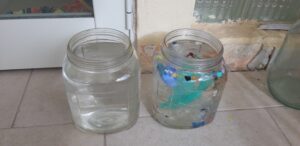BeMED 17. Investigating the effects of marine litter on sea water temperature and pH level
Title |
Investigating the effects of marine litter on sea water temperature and pH level |
Author |
Ramona Mercieca |
Age Guide |
Year 7-8 |
Subject Area |
Geography, Integrated science |
| Preparation Time | 1 hour |
| Estimated Duration | Data collection 10 mins daily spread over 2 months |
| Site | School ground |
| Educational objectives | To develop fieldwork skills such as collecting and recording data
To learn more about the effects of marine litter |
| Learning Outcomes | – I can justify the importance of identifying problems, reflecting critically, thinking creatively and having a wider vision in order to plan for the future and become an effective agent of change.
– I can use the natural, social and built environment that surrounds me, as a context and source of learning. – I am motivated to make a positive contribution to other people and their social and natural environment, locally and globally. – I can reflect upon the consequences of my actions on present and future generations. |
| Link to SDGs | SDG 3: Good health and well-being
SDG 4: Quality education SDG 11: Sustainable cities and communities SDG 12: Responsible consumption and production |
| Educational resources required | 2 big glass jars
Sea water Plastic litter Digital pH reader Digital thermometer Data logger to measure air temperature, humidity and air pressure GLOBE Observer App to record cloud type and cover (optional) Appendix 17.1 – Data sheets
|
| Remote preparation | Organize a beach clean-up event. Marine litter collected to be taken at school to be used in investigation. Collect sea water samples in a small jerry can. |
| Planning Considerations | Very important to focus on the FACTS, especially when researching and collecting data about the effects of marine litter.
For beach clean-up event: · Healthy and Safety information (stay in groups, stay away from the sea and cliffs, hazard of roads and weather). · Brief outline of day and objectives for the day. Set up the day’s investigation aim and consider hypotheses. Toilet stops and time for the lunch break. · Risk assessment/class list/medication/first aid kits |
| Method | Introduction
In this activity students will investigate the effects of plastic litter on sea water temperature and sea water pH levels. Two large glass jars are filled with the same amount of sea water. In one of the jars the students put some plastic litter collected during the beach clean-up event done beforehand. The glass jars are to be placed outside exposed to the sun and rain. Development Every day students will take three readings of the sea water temperature and pH level from both jars and calculate the mean of the three samples. Moreover, the students will measure the air temperature, humidity and air pressure, describe the general outlook of the weather and observe cloud cover using the GLOBE Observer App (optional). Information collected is filled in the data sheets (Appendix 17.1). Conclusion Once all data is collected students will present it in a graph and analyze it through mean values of repetitions (pH and temperature) by jar to both treatments (with plastics, without plastics). The mean values are to be plotted along the time to verify the changes between both treatments. The data collected will help determine whether there is an effect on the sea water temperature and sea water pH level as a result of marine litter and that there is a relationship between them. |
| Background information for educators | Ocean Crusaders http://oceancrusaders.org/
International Maritime Organization https://www.imo.org/ Marine Pollution Bulletin · February 2018 www.researchgate.net Download the GLOBE Observer App and create an account with the GLOBE Program: https://observer.globe.gov/ |




